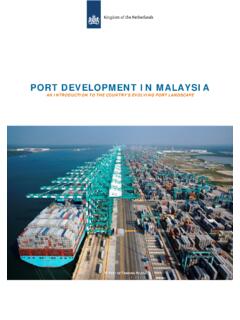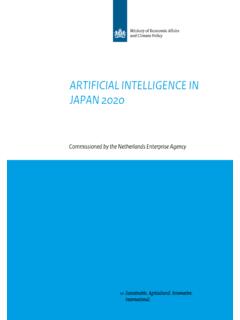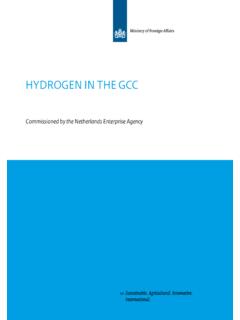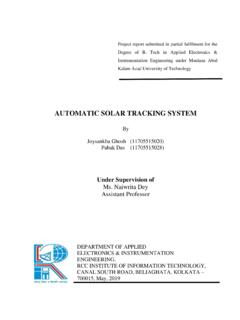Transcription of Final Energy report Kenya - RVO
1 Final Energy report Kenya Commissioned by the Netherlands Enterprise Agency report Kenya Author: Kees Mokveld & Steven von Eije ( ) Date: 30-7-2018 Version: 6 ( Final ) RVO 1. Kenya General overview .. 2 2. Energy 3 3. Renewable Energy .. 7 4. Energy 9 5. Governmental framework .. 10 6. Regulatory framework .. 13 7. Access to 16 8. Opportunities and barriers for Dutch 17 9. Dutch companies active in Kenya .. 19 10. Relevant Dutch support schemes .. 20 11. Relevant international donors .. 24 Annex 1 References .. 27 Annex 2 Legislation .. 28 Disclaimer This document is based on information which is publicly available on the internet.
2 The used publications and websites are mentioned in the Annex 1 of this document. The information is checked with other sources. The information in Chapter 7 is based on interviews with several experts. No rights can be derived from the information provided in this report and the statements in the report remain the responsibility of the authors and do not necessarily reflect the position of the Dutch Government. While the Netherlands Enterprise Agency has exercised the utmost care in the editing and redaction of this report , it must disclaim all responsibility and liability for any and all possible oversights with regard to content completeness. 1 1. Kenya General overview Official name Republic of Kenya Area (km2) (14x Nederland) Land Area (km2) (17x Nederland) Population (3x Nederland) GDP per capita (2016 est) (WB) $ Agriculture tea, coffee, corn, wheat, sugarcane, fruit, vegetables; dairy products, beef, fish, pork, poultry, eggs The horticultural industry is growing by 20% annually.
3 Industry small-scale consumer goods (plastic, furniture, batteries, textiles, clothing, soap, cigarettes, flour), agricultural products, horticulture, oil refining; aluminum, steel, lead; cement, commercial ship repair, tourism, information technology CO2 emissions (t CO2/capita) Price of electricity (US cents/kWh) Source: CIA Factbook, World Bank and 2 2. Energy overview Overview of the Energy sector/General description Kenya s economic growth has put the country s electricity supply under increasing pressure. Between 2004 and 2013 power demand rose by annually. Under the Least Cost Power Development Plan, the country is focusing on the development of geothermal and hydroelectric power plants.
4 After a 280 MW geothermal plant was commissioned in early 2015, electricity tariffs were decreased by up to 30% depending on the customer group. [1] As concerns production of electricity, the existing capacity is barely able to keep up with demand. Given that more than 39% (2015) of Kenya s electricity comes from hydropower, the situation is particularly difficult during the summer months when water levels are low. Capacity gaps are then compensated by expensive thermal generation based on fossil fuels. Increasing economic activities and a rising national population lead to a higher domestic Energy demand in Kenya , which is mostly satisfied by imports of foreign Energy . The high cost of Energy imports significantly slows economic growth in the country. Imported crude petroleum, for instance, accounts for about 25% of the national import bill.
5 The problem of high Energy costs is supplemented by the unreliability of Energy supply infrastructure. On average, Kenyan companies lose nearly 10% of their production because of power outages and fluctuations. Sustainable, affordable and reliable domestic Energy for all citizens is, therefore, declared a priority factor in national policy. [3] As utility-scale projects face a lengthy planning process, developers have started to target captive generation projects. The approval process for on-site power generation up to 1MW is far simpler and all projects below 3MW do not require a generation permit, which can be a lengthy process to obtain. The generation technology of choice is typically solar , although small hydro has been favoured in some regions especially by the Kenya Tea Development Agency.
6 [5] Primary Energy use/ Energy supply Total Primary Energy Supply ktoe Coal 349 Crude Oil 701 Oil products 3659 Natural gas 0 Nuclear 0 Hydro 326 Geothermal, solar , wind, etc. 3855 Biofuels and waste 16208 Electricity 2 Heat 0 Total 25100 Source IEA Statistics 2015 3 Energy consumption Total Final consumption ktoe Coal 349 Crude Oil 0 Oil products 3951 Natural gas 0 Nuclear 0 Hydro 0 Geothermal, solar , wind, etc. 0 Biofuels and waste 10771 Electricity 682 Heat 0 Total 15753 Source IEA Statistics 2015 Electricity use per sector Final Electricity Consumption GWh Industry 4229 Transport 0 Residential 2544 Commercial and Public Services 1153 Agriculture/Forestry 0 Fishing 0 Other non-specified 0 Finale Electricity Consumption 7926 Source IEA Statistics 2015 4 Electricity production Electricity production GWh Coal 0 Oil(12%) 1205 Gas 0 Biofuels (solid biofuels) 122 Waste 0 Nuclear 0 Hydro (39%) 3787 Geothermal (46%)
7 4479 solar PV 1 solar thermal 0 Wind 57 Tide 0 Other sources 0 Electricity production 9651 Source IEA Statistics 2015 Transmission and distribution The national grid is operated as an integrated network linked by a 220 kV and a 132 kV transmission system; there are also a limited number of 66 kV transmission lines. The grid is one of the main challenges for the sector, and deficiencies lead to frequent power outages as well as technical and non-technical losses. As a result, the grid operators, KPLC and Ketraco, have put the emphasis on system reliability and the introduction of smart grid technologies. The authorities are currently extending transmission lines (4,000 km) and distribution lines (3,200 km), and building substations (4,200 MVA). Two pilot projects are aimed at introducing smart grid technologies in parts of Nairobi and Mombasa.
8 [1] Access to electricity (2015) % of the population Electrification total % 56 % Electrification urban areas % 78 % Electrification rural area % 39 % Access to clean cooking 13 % Source TRACKING SDG7: THE Energy PROGRESS report 2018 Off-Grid Electrification The Kenyan Government is working to rapidly increase electrification rates in both urban and rural areas. As part of its national Vision 2030 to create a globally competitive and prosperous nation with a high quality of life by 2030 Kenya aims to grow rural electricity access to 40% by 2024. [3] The low rural electrification rate of requires grid extension and electrification projects in remote areas of the country. Kenya s Rural Electrification Authority is concentrating mainly on the expansion of greenfield photovoltaic (PV) mini-grids and on retrofitting existing diesel-powered mini-grids.
9 [1] 5 Several programs exist to expand distribution lines, reach remote villages, and maximize the utilization of existing transformers by connecting people within their immediate reach or in informal settlements underneath, often subsidized by DFIs. These have started to make an impact on Energy access numbers. Kenya s electrification rate rose from 26% in 2012 to 55% as of mid-2016. Mini-grid capacity is rapidly growing in Kenya , despite uncertainties around geographic territory clauses in distribution tariffs. Kenya has become one of the best-served off-grid populations in the world, featuring some of the most advanced pay-as-you-go solar home system companies and innovative business models for mini-grid development. [5] 6 3.
10 Renewable Energy Kenya has promising potential for power generation from renewable Energy sources. Abundant solar , hydro, wind, biomass and geothermal resources led the government to seek the expansion of renewable Energy generation to central and rural areas. Following a least-cost approach, the government has prioritised the development of geothermal and wind Energy plants as well as solar -fed mini-grids for rural electrification. [1] Bio- Energy The country s agricultural activity produces large amounts of agricultural waste. These can be used to produce electricity by implementing biogas and biomass technologies. The 2014 National Energy Policy Draft also sets out biogas expansion targets of 10,000 small and medium-sized digesters by 2030. Biogas is considered a viable Energy solution by a number of agricultural producers.















